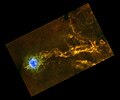Cocoon mist
| Data from IC 5146 (Cocoon Nebula) Nebula with embedded star cluster |
|
|---|---|

|
|
| Image from IC 5146. To the right of the nebula, the elongated Barnard 168 dark cloud can be seen. | |
| Constellation | swan |
|
Position equinox : J2000.0 |
|
| Right ascension | 21 h 53 m , 5 |
| declination | + 47 ° 16 ′ |
| Appearance | |
| Apparent brightness (visual) | +7.2 mag |
| Angular expansion | approx. 10 ' |
| fog | |
| Fog type | Emission / reflection / absorption |
| Ionizing source of the emitting part | embedded star cluster Collinder 470 and above all the 10-mag star BD + 46 ° 3474 (type B0 V) in its center |
| Star clusters | |
| classification | III 2 pn (Trumpler) |
| Number of stars | about 100 |
| Physical data | |
| Affiliation | Milky Way |
| distance | (3100 ± 300) ly / (950 ± 80) pc |
| diameter | approx. 10 ly |
| history | |
| discovery | Edward Barnard , October 11, 1893; regardless of this: Max Wolf , July 28, 1894 |
| Catalog names | |
| fog | IC 5146, Sh2-125, LBN 424, Ced 198, min 2-70 |
| Star clusters | Cr 470, OCl 213, Lund 1001, C 2151 + 470 |
IC 5146 , also known as the Cocoon Nebula , is an astronomical nebula with an embedded open star cluster in the constellation Swan . The star cluster is called Collinder 470 .
The nebula has an apparent extension of around 10 arc minutes and is about 3,000 light years from Earth; its physical extent is about 10 light years.
The nebula is a star formation region with ionized atomic hydrogen and has both emitting , reflecting and absorbing components.
When viewed from Earth, IC 5146 is located at the eastern end of the elongated dark cloud Barnard 168 and, together with it, is part of an extended molecular cloud . A little to the west is the reflection nebula of vdB 147, which probably also belongs to the complex.
The active star formation taking place inside the cloud leads to the formation of a young open star cluster called Collinder 470, an apparent magnitude of 7.2 mag and an estimated age of a few hundred thousand years. This star cluster and especially the brightest star in its center, BD + 46 ° 3474 (type B0 V, 10 mag), are responsible for the ionization of the nebula and thus for its glow. They create a "cave" in the dust and gas of the molecular cloud and thus open up a view into its interior.
The nebula was discovered photographically by Edward Barnard on a photo taken on October 11, 1893, and later independently by Max Wolf (July 28, 1894).
See also
Image taken by the Herschel Space Telescope
Web links
- IC 5146 at Universe Today (Tammy Plotner: "The Cosmic Cocoon: IC 5146 by Tom V. Davis")
- Wolfgang Steinicke: "IC 5146" (PDF file; 199 kB)
- SIMBAD request for IC 5146
- WEBDA page for IC 5146
- IC 5146 - the Cocoon Nebula - Astronomy Picture of the Day of August 27, 2008.
- Spektrum.de : Amateur recordings [1] [2] [3] [4]
Individual evidence
- ^ GH Herbig, SE Dahm: "The Young Cluster IC 5146" ; in: The Astronomical Journal, Vol. 123, Issue 1, p. 304 (English)
- ↑ a b Wolfgang Steinicke: "IC 5146" (PDF; 203 kB)
- ^ Harvey et al .: The Spitzer Survey of Interstellar Clouds in the Gould Belt. - I. IC 5146 Observed With IRAC and MIPS ; in: The Astronomical Journal, Vol, 680, Issue 1, p. 495, bibcode : 2008ApJ ... 680..495H (English)

